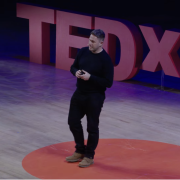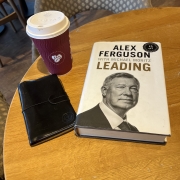For me, Sir Alex Ferguson is the godfather of ‘man management’. It’s not just the longevity of managing at the highest level in world football, it’s the consistent success he had throughout his career as a leader.
Tactics, ability to sign great players and being able to watch a football match unfold and know what changes need to be made. These are all some of the attributes that make good football managers. However, communication is what separates the good managers from the great managers.
One of the books I dip in and out of very often is Leading which is co-written by Sir Alex Ferguson and Sir Michael Moritz. The book is structured around the key skills that Ferguson values highest. It is aimed at giving the reader lessons in leadership that anyone can apply to their own situation.
The one chapter that I’ve dipped into the most, and used in plenty of my training courses is Chapter 8 -Owning The Message. This is the chapter that is dedicated to speaking, writing and answering questions.
Alex Ferguson had to communicate with a lot of people on a day to day basis as the manager of one of the biggest sporting organisations in the world. Players, coaching staff, owners/directors, media, supporters and the global audience. How was he so successful at communicating?
Despite how hard I’ve looked at this and analysed how complex or profound the answer could be, it’s actually a little bit anticlimactic in some ways.
Keep it simple.
That’s it. Nothing fancy. Just keep the message that you want to deliver simple and clear to understand.
It’s not rocket science, but as easy as that looks and sounds; keeping it simple takes a hell of a lot of work.
Know your audience
“I got into the habit of imagining that I was in the shoes of the listener. I knew from my own experience as a player what it was like to listen to a manager drone on, especially if it was the day before a game, and you were just raring to get onto the training field and blow off some steam.”
He also explains the importance of keeping his team talks ‘short and punchy’ but still getting his point over. To do this, he had to know exactly what message he wanted to convey and how he would deliver it.
As football became more global, he was dealing with international players from all over the world. Language was a barrier. And if his team talks were being translated then it was essential that messages and meaning weren’t being lost in translation.
Next time you’re needing to explain something to someone, imagine how you would say it to a translator for them to explain your words to another person.
Despite playing at the top level of competition in the world with some of the best players on the planet. Sometimes the simple messages were the most effective and easiest to understand:
“The instructions i gave most frequently were very short. They were nothing more complicated than ‘Keep the ball’ or ‘Do not let them score’”.
Know what you want to say
“You need to know what you want to say; you have to contemplate how you are going to deliver the message; and you have to maintain control of the audience.”
Preparation is so important when planning on delivering a message. Ferguson was always aware of not wanting to deliver a ‘sermon’ that the players had possibly heard him say in the past. He would find new ways to get a message across to emphasise his point.
He explains how he used the Canadian Geese in their flying formation as an example of team work. On one occasion he told a story of his recent trip to his first live performance of a classical music concert. He described to the players how the conductor wanted the same things from the musicians as Ferguson wanted from them: control, harmony, tempo, timing and rhythm.
He planned this conversation and took the time to work out how he would deliver his message using the metaphor.
Alex Ferguson calls this ‘maintaining control of the audience’. For me this is creating engagement. Making sure that he was never repeating himself to agonise over the same old points with players and always thinking of new ways to get his message over.
“Whether the audience is one person or 75,000, you need to assemble your thoughts, know what you want to emphasise and just say it.”
How you say it
“One message that seemed to strike home (at least judging by the number of players who appear to have remembered it) were the words i used at the half-time during the 1999 Champions League final when we were trailing Bayern Munich 1-0. I said’ ‘When that cup is going to be presented, just remember that you can’t even touch it if you’re the losers – you’ll be walking past it with your losers’ medals, knowing someone walking behind you is going to lift the Cup.’”
Alex Ferguson had a reputation for being a feisty character. The phrase ‘the hairdryer treatment’ had been coined by pundits to describe what it felt like to face the angry side of the feisty Scotsman. But this persona was often over-played by the media. No one would have lasted the length of time in leadership at the top level if they had only communicated using anger and raised voices.
He knew exactly at what point to deliver his message to his players and how he should do it. In the book, he mentions the power of giving a player positive reinforcement to make them feel better about themselves rather than using negative feedback. He would never tell a player if they were looking tired, even if he could see it. Instead he built them up to feel stronger.
He knew which players would respond positively and which ones wouldn’t to different ways of saying something. He knew when would be the best time to make his remarks more punchy and when saying less got more.
Using the power of silence can be just as powerful.
“Sometimes, after we had a bad result, I would finish what i had to say to the players and then sit down on the bench and say nothing. The subsequent quietness was probably more effective than anything i said.”
Sir Alex Ferguson knew how to get the best out of people. And although he had great players, coaches and a wealth of experience in the game. One of the main reasons for his success is how communicated. He delivered a message of success to players in a rapidly changing environment consistently. This takes huge skills to keep your message relevant over such a long period of time.
But the beauty of what he did is that he kept it simple. Regardless of whether it was a 1 to 1 conversation with an individual or addressing a stadium full of 75,000 people. He never overcomplicated it and always got his message across.
I would strongly recommend buying this book. If you’re like me and don’t have the attention to sit and read a book cover to cover, this book is ideal to dip in and out of for small reminders.






